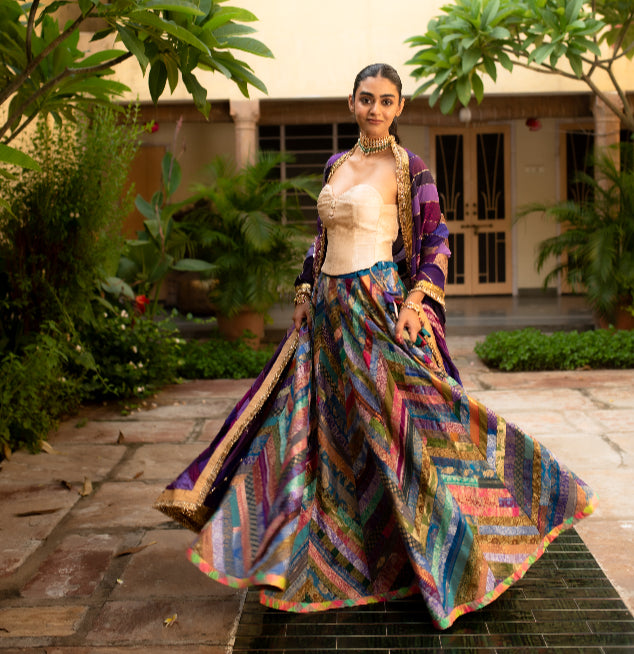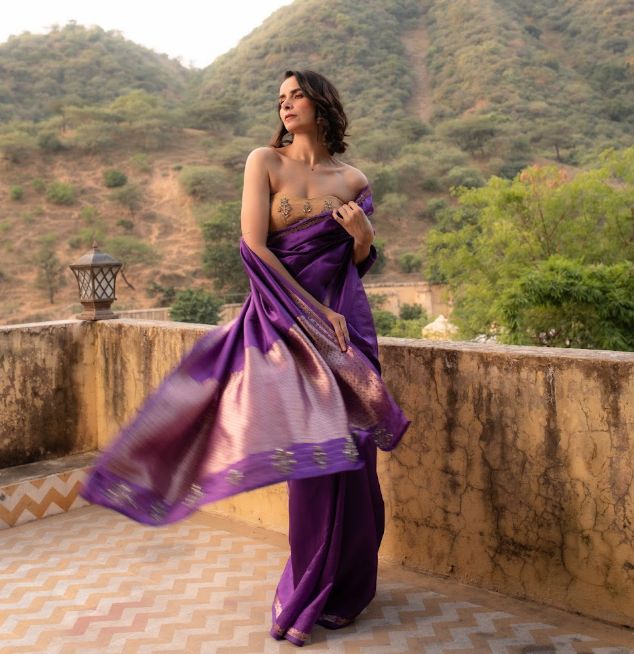Why Dupattas are must have for Festive Season?

Introduction to Why Dupattas are must have for Festive Season

Originating as an essential attribute of traditional clothing in South Asia, the dupatta has come of age in form and function since eons. Dupattas can be traced back to ancient times when they were primarily worn as a symbol of modesty and respect. Historical texts and scriptures, including the Rigveda and other ancient Indian literature, provide early mentions of garments resembling dupattas.
In the early Vedic period (1500–500 BCE), clothing was simple and unstitched, consisting mainly of draped fabrics. During the Gupta period (4th to 6th century CE), the dupatta became an integral part of the ensemble men and women alike, often portrayed in sculptures and paintings of the time.
In various parts of India, the dupatta has held cultural and religious importance. For instance, in ceremonial rituals, brides often wear a red dupatta, symbolizing prosperity and marital bliss. Throughout history, the dupatta has not only served a functional purpose but has also been a canvas for artistic expression.
During the Mughal era (16th to 18th century), the dupatta gained prominence as a fashion statement, adorned with intricate embroidery, zari work, and embellishments. The Mughals, known for their luxurious and opulent lifestyle, elevated the status of the dupatta, making it a symbol of royalty and elegance.
The dupatta's journey from a simple piece of cloth to an elaborate fashion accessory reflects the socio-cultural changes in Indian society. It has been used to convey social status, with richer fabrics and more elaborate designs indicating higher social standing.
As far as the vibrant tapestry of ethnic wear goes, the dupatta for women holds an unparalleled place, symbolizing elegance, tradition, and panache. This timeless accessory, draped in rich history and cultural significance, transforms any outfit into a masterpiece, especially during the festive season.
With year-round festivities, the stunning collection of women’s dupattas online transcends its role as a mere accessory to become a statement piece that completes your ensemble. Its flowing elegance, rich textures, and intricate designs capture the essence of tradition and festivity, allowing you a distinguished look to stand out in the crowd.
Whether it’s the lavish feel of silk, the dainty embroidery of Chikankari, or the vibrant hues of Bandhani, the dupatta adds a touch of sophistication and grandeur to your outfit that too in absolutely no time. This festive season, embrace the effervescent dupatta’s versatility and cast a spell on the onlookers with its unique charm.
From the sumptuous Banarasi silk that exudes royal elegance to the playful Phulkari that brings a burst of joy, each dupatta tells a unique story of craftsmanship and heritage.Discover the joy of styling these beautiful pieces to create unforgettable festive looks, and learn the best ways to care for them, ensuring they remain as stunning as the day you first wore them If you’ve treated your dupatta as just an average accessory all this time, it's time to rethink.
These gorgeous offerings — paired with out-of-the-box draping styles — can add volumes to every outfit you try. Here are our specially curated styling ideas to inspire your festive look. Well, It’s time to get crafty, we say.
What is the Importance of Dupatta for the Festival?

The innate sacredness, purity, and traditionality that is effortlessly a part of this garment, makes it even more special, as far as a traditional affair or festival goes. Precisely the reason why women prefer donning a dupatta to harmonious and sacred rituals.
The dupatta’s striking characteristic to completely transform a simple outfit into a royal ensemble makes it an indispensable part of women’s ethnic wear without any second thought. Be it the floor grazing aspect or the flowing elegance, the women’s dupattas capture the essence of celebration and tradition without compromising on your style, making every moment memorable and picture-perfect.
Benefits of Having Different Types of Dupattas
Having a variety of dupattas in your wardrobe allows you to experiment with looks and styles in abundance. Any dupatta be it silk, chiffon, or cotton, brings to the table its own unique charm and adaptability. A richly embroidered silk dupatta can add opulence to a simple kurta, while a light, airy chiffon dupatta offers comfort and elegance. Different dupattas cater to different occasions, ensuring that you are always prepared to make a style statement.
Types of Dupattas Perfect for the Festive Season
1. Banarasi Silk Dupatta:

Known for its evergreen opulent fabric and delicate weaves, the Banarasi silk dupatta is appropriate for finishing off your festive look with elan.
2. Chikankari Dupatta:

With dainty embroidery that exudes sophistication, the Chikankari dupatta is ideal for a subtle yet chic appearance.
2. Phulkari Dupatta:

Vibrant and colorful, the Phulkari dupatta brings a burst of festivity and joy, making it perfect for lively celebrations.
3. Bandhani Dupatta:

This traditional tie-dye dupatta adds a playful and ethnic touch to your outfit, reflecting the spirit of Indian festivals.
Styles for Your Festive Look with Dupattas
Styling your dupatta can dramatically enhance your festive look. Here are a few stylish ways to drape your dupatta:
1. Belted Beauty:

Cinch your dupatta at the waist with a stylish belt for a contemporary twist.
2. The Cape Drape:

Drape the dupatta over your shoulders like a cape for a regal, ethereal look.
3. Side Swept Style:

Sweep the dupatta to one side for an asymmetrical and dramatic flair.
4. Lehenga Wrap:

Wrap the dupatta around your lehenga for a seamless and sophisticated silhouette.
5. Double Dupatta Drama:

Layer two dupattas for an opulent and striking ensemble.
6. Half-Saree Style:

Drape the dupatta like a saree pallu for a fusion of traditional and modern aesthetics.
7. Head Covering finesse:

Use the dupatta to cover your head gracefully, adding a touch of modesty and tradition.
8. Flowing Train:

Let the dupatta trail lie behind you like a train for a princess-like avatar.
9. Front Drape:

Drape the dupatta in the front for a unique and contemporary twist.
10. Knotted Ends:

Knot the ends of the dupatta for a playful and casual look.
Accessorizing Dupattas for a Festive Glow
Pair your dupatta with statement earrings, an exquisite maang tikka, or a chunky and bold neck piece. You can further glamourize with a brooch to your dupatta and can also curate a unique and truly defining your personal sartorial style. Ensure that your accessories complement the colours and design of your dupatta for a harmonious and festive ensemble.
Caring for Your Dupattas for the Coming Festival
Proper care and maintenance ensures that your dupattas remain pristine and beautiful for years to come. Store your dupattas in a cool, dry place, preferably wrapped in muslin cloth to protect them from dust and moisture. Make sure you hand wash delicate fabrics like silk and chiffon with mild detergents, and avoid exposing them to direct sunlight which is an obvious thumb rule in wardrobe care. Regularly airing and refolding your dupattas can prevent creases and maintain their freshness.
Conclusion:
The dupatta attributes grace and cultural heritage, and holds a significant place in ethnic wear for women. As an eternally favourite piece, it effortlessly transcends generations, weaving together tradition and modernity. For you, this exquisite accessory becomes more than just a piece of fabric; it is an embodiment of the Artistry of Indian Heritage—a testament to the intricate craftsmanship and rich history that defines our rich culture.
Every fold, every thread of the dupatta tells a story of our team of skilled karigars, whose hands breathe life into the fabric, transforming it into an impeccable masterpiece. Whether it’s the dainty embroidery, the gleaming beadwork, or the vibrant colours that translate the vitality of India’s diverse regions, sundry cultures and more and each dupatta is just a celebration of India and YOU. It speaks to your connection with the country's artistic legacy and your personal style, bringing together heritage and individuality in a beautiful fusion.
At Priyanka Raajiv, we understand the essence of this cherished piece of the wardrobe. The dupatta is more than just an adornment; it’s a piece of art, crafted with precision and love, intended to elevate your festive wardrobe. Whether paired with a lehenga, kurta, or sari, it adds an unmatched elegance and charm, ensuring that you stand out at every celebration.
At Priyanka Raajiv, we celebrate YOU, the art and the artistry with every collection.
FAQ
Q1. Which type of dupatta is best?
Ans. The best type of dupatta depends on the occasion and your outfit. Banarasi silk dupattas are perfect for grandiose, big affairs, while the lighter, feather-like dupattas are great for more casual style.
Q2. What is the history of the dupatta?
Ans. The dupatta has a rich history that dates back to ancient India. Originally a symbol of modesty and respect, it has evolved into a versatile accessory that complements traditional and contemporary outfits.
Q3. How to take a stylish dupatta?
Ans. To style a dupatta stylishly, experiment with different draping techniques such as the classic drape, front drape, belted style, or cape style. Pairing it with the right accessories also enhances its beauty.
Q4. Which city is famous for dupatta?
Ans. Several cities in India are renowned for their dupattas. Varanasi is famous for Banarasi silk dupattas, Lucknow for Chikankari, and Punjab for Phulkari dupattas.
Q5. What is the significance of the dupatta?
Ans. The dupatta signifies grace, tradition, and cultural heritage. It is a versatile accessory that adds elegance and sophistication to any outfit, making it a significant part of Indian attire.

